Riley Bailey
The Russian government quickly signaled on September 19 that Russian peacekeeping forces would not intervene in Azerbaijan’s military operation into Nagorno-Karabakh, despite Russia’s previous security ties to Armenia. The Azerbaijani Ministry of Defense (MoD) announced that Azerbaijani forces began a military operation into Nagorno-Karabakh on September 19.[1] Kremlin Spokesperson Dmitry Peskov claimed that the Russian military is in contact with Armenian and Azerbaijani officials “at the highest level.”[2] Russian Foreign Ministry Spokesperson Maria Zakharova issued a general statement calling on “all sides” to stop the bloodshed, claimed that the Russian peacekeeping contingent in Nagorno-Karabakh continues to fulfil its assigned tasks, and cited the trilateral Russian-Armenian-Azerbaijani agreements signed in 2020 and 2022 as a path toward peace.[3] Russian State Duma Defense Committee Chairman Andrei Kartapolov stated that the Russian peacekeeping contingent does not have the right to use weapons unless directly threatened.[4] A Kremlin-affiliated milblogger claimed that the Russian peacekeeping contingent lacks any protocols on the use of force or rules of engagement in Nagorno-Karabakh, and instead operates on the basis of the November 2020 Nagorno-Karabakh peace agreement.[5] Russian Security Council Deputy Chairperson Dmitry Medvedev and RT Editor-in-chief and Russian propagandist Margarita Simonyan (both notably nationalistic and extreme voices in the Russian government) claimed that Armenia is experiencing the repercussions of its recent efforts to align with the West and distance itself from Russia.
However, mainline Russian government officials did not promote this framing and maintained equivocal language calling for an end to the fighting.[6] Russian milbloggers expressed support for the safety of the Russian peacekeeping contingent in Nagorno-Karabakh while lamenting Russia’s waning influence with Armenia and Azerbaijan.[7] The Russian military is unlikely to prioritize peacekeeping operations in Nagorno-Karabakh against the backdrop of the war in Ukraine, and minimal Russian peacekeeping operations in Nagorno-Karabakh are unlikely to affect Russian military operations in Ukraine.
Russian and Ukrainian sources credited superior Ukrainian combat coordination, more precise artillery fire, and stronger electronic warfare (EW) systems for recent Ukrainian advances south of Bakhmut amid continued discussions of significant Russian losses in the area. Ukrainian personnel that participated in the recent liberation of Klishchiivka (7km southeast of Bakhmut) stated on September 18 that high morale, sufficient training, sufficient resources for artillery fire and drone strikes, good coherence between Ukrainian units, and detailed reconnaissance enabled Ukrainian forces to advance.[8] One Ukrainian commander stated that elements of various Russian units defending in the area suffered from a lack of coherence.[9] Russian Airborne (VDV), Spetsnaz, and 3rd Army Corps elements defended near Klishchiivka; and persistent issues with horizontal integration among Russian forces in Ukraine likely prevented these disparate Russian elements from sharing information and coordinating combat operations.[10] A prominent Russian milblogger claimed that Ukrainian artillery units south of Bakhmut are increasingly accurate and precise, enabling Ukrainian forces to safely shell Russian advances closer to Ukrainian positions.[11] The milblogger claimed that Ukrainian forces have advantages in aerial reconnaissance as well as stronger EW systems.[12]
A Russian milblogger with close ties to the VDV acknowledged that elements of the 83rd Guards VDV Brigade, which were defending near Klishchiivka, are now reconstituting in rear areas and that elements of the 31st Guards VDV Brigade continue to defend near the settlement.[13] Russian milbloggers claimed that elements of the Russian 72nd Motorized Rifle Brigade (3rd Army Corps) are still operating in the Bakhmut area, although Ukrainian forces have likely rendered these elements combat ineffective.[14] Ukrainian Ground Forces Commander Oleksandr Syrskyi stated on September 18 that Ukrainian forces completely destroyed the combat capabilities of elements of the 72nd Motorized Rifle Brigade, the 31st VDV Brigade, and the 83rd Brigade during the liberation of Andriivka and Klishchiivka.[15] ISW previously assessed that Ukrainian advances in western Zaporizhia Oblast may correspond with the degradation of Russian forces defending in that sector of the front and that recent Ukrainian advances south of Bakhmut may correspond with a similar degradation of Russian forces.[16]
Russian losses have reportedly significantly increased in western Zaporizhia Oblast in recent days, and the Russian military likely struggles with a lack of available combat-effective units that the Russian command is willing to laterally redeploy to this sector of the front. Ukrainian Tavriisk Group of Forces Spokesperson Colonel Oleksandr Shtupun stated that Russian forces lost 313 personnel (likely a total of killed and wounded) in the Tavriisk direction on September 18, including western Zaporizhia Oblast. Shtupun stated that this is significantly higher than Russian losses during the previous two days when Russian forces lost roughly 200 personnel each day.[17] Shtupun stated that Russian Airborne (VDV) forces are conducting defensive operations in the Tavriisk direction (likely in western Zaporizhia Oblast) and that “Storm-Z” detachments with convict recruits have arrived to act as “cover” for VDV units, possibly referring to the need to cover the VDV units during a potential withdrawal.[18] ISW has previously observed elements of the 7th Guards Mountain VDV Division and 76th Guards VDV Division conducting counterattacks against Ukrainian forces in the Robotyne (10km south of Orikhiv) area, and ISW has previously assessed that these operations have likely degraded these VDV forces heavily.[19] “Storm-Z” detachments are often combat ineffective and will likely provide the Russian defense in western Zaporizhia Oblast with marginal combat power.
Russian forces conducted a series of Shahed-131/-136 drone and ballistic missile strikes on Ukrainian rear areas on September 19. Ukrainian military officials stated that Russian forces launched 31 drones from Krasnodar Krai and 1 Iskander-M ballistic missile from occupied Crimea and that Ukrainian forces shot down 28 drones.[20] The Ukrainian State Service for Emergency Situations reported that Russian drones hit industrial warehouses in Lviv, and the Ukrainian General Staff reported that the Russian Iskander missile hit Kryvyi Rih, Dnipropetrovsk Oblast.[21] US Secretary of Defense Lloyd Austin stated on September 19 that Russian strikes on Ukrainian port and grain infrastructure have destroyed at least 280,000 tons of grain in recent months, which he stated would have been enough to feed up to 10.5 million people for a year.[22]
Russian Defense Minister Sergei Shoigu met with Iranian Armed Forces General Staff Chief Major General Mohammad Bagheri in Tehran, Iran on September 19. Shoigu and Bagheri discussed Russian–Iranian bilateral military cooperation and the situation in Nagorno-Karabakh, Syria, and Afghanistan.[23] Shoigu stated that Russian–Iranian military relations are developing “dynamically and positively.”[24] A Kremlin-affiliated Russian milblogger claimed that the Russian Ministry of Defense (MoD) planned Shoigu’s visit to Tehran in advance and that it was not coordinated with Azerbaijan’s escalation in Nagorno-Karabakh.[25] The milblogger also claimed that Shoigu aimed to expand military-technical cooperation with Iran and hypothesized that Russia may be interested in expanding Iranian Shahed drone production on Russian territory.[26]
The Kremlin continues efforts to strengthen its control of the Russian information space ahead of the September 2024 Russian presidential elections. The Russian government announced a ban on services that provide virtual mobile numbers, which includes temporary numbers that individuals can use to sign up for anonymous social media accounts without using their personnel credentials, starting on September 1, 2024.[27] This measure likely aims to crack down on anonymous Telegram accounts that criticize the Kremlin and allows the Kremlin to better control the Russian information space. Announcing this measure a year ahead of its implementation is likely a soft rollout designed to gauge a possible information space reaction to the announcement and allow time to soften or strengthen the measure as the implementation and presidential elections approach. The Russian government will reportedly provide a list of alternative services to allow individuals to anonymously sign up for social media accounts, but it is very unlikely that these alternatives will allow individuals to maintain a similar degree of anonymity from the Russian government as existing virtual mobile number services currently afford.[28]
Ukrainian President Volodymyr Zelensky delivered a speech at the United Nations on September 19.[29] ISW will cover Zelensky’s trip to the United States after his upcoming visit to Washington, D.C.
Key Takeaways:
- The Russian government quickly signaled on September 19 that Russian peacekeeping forces would not intervene in Azerbaijan’s military operation into Nagorno-Karabakh, despite Russia’s previous security ties to Armenia.
- Russian and Ukrainian sources credited superior Ukrainian combat coordination, more precise artillery fire, and stronger electronic warfare (EW) systems for recent Ukrainian advances south of Bakhmut amid continued discussions of significant Russian losses in the area.
- Russian losses have reportedly significantly increased in western Zaporizhia Oblast in recent days, and the Russian military likely struggles with a lack of available combat effective units that the Russian command is willing to laterally redeploy to this sector of the front.
- Russian forces conducted a series of Shahed-131/-136 drone and ballistic missile strikes on Ukrainian rear areas on September 19.
- Russian Defense Minister Sergei Shoigu met with Iranian Armed Forces General Staff Chief Major General Mohammad Bagheri in Tehran, Iran on September 19.
- Russian forces conducted offensive operations along the Kupyansk-Svatove-Kreminna line, near Bakhmut, along the Avdiivka-Donetsk City line, and in western Zaporizhia Oblast but did not advance on September 19.
- Ukrainian forces conducted offensive operations in at least two sectors of the front on September 19 and advanced along the Kupyansk-Svatove-Kreminna line and in western Zaporizhia Oblast.
- A Latvian company has reportedly been exporting chips and microcircuits to Russian defense industrial base (DIB) companies despite international sanctions designed to prevent Russia from importing such components.
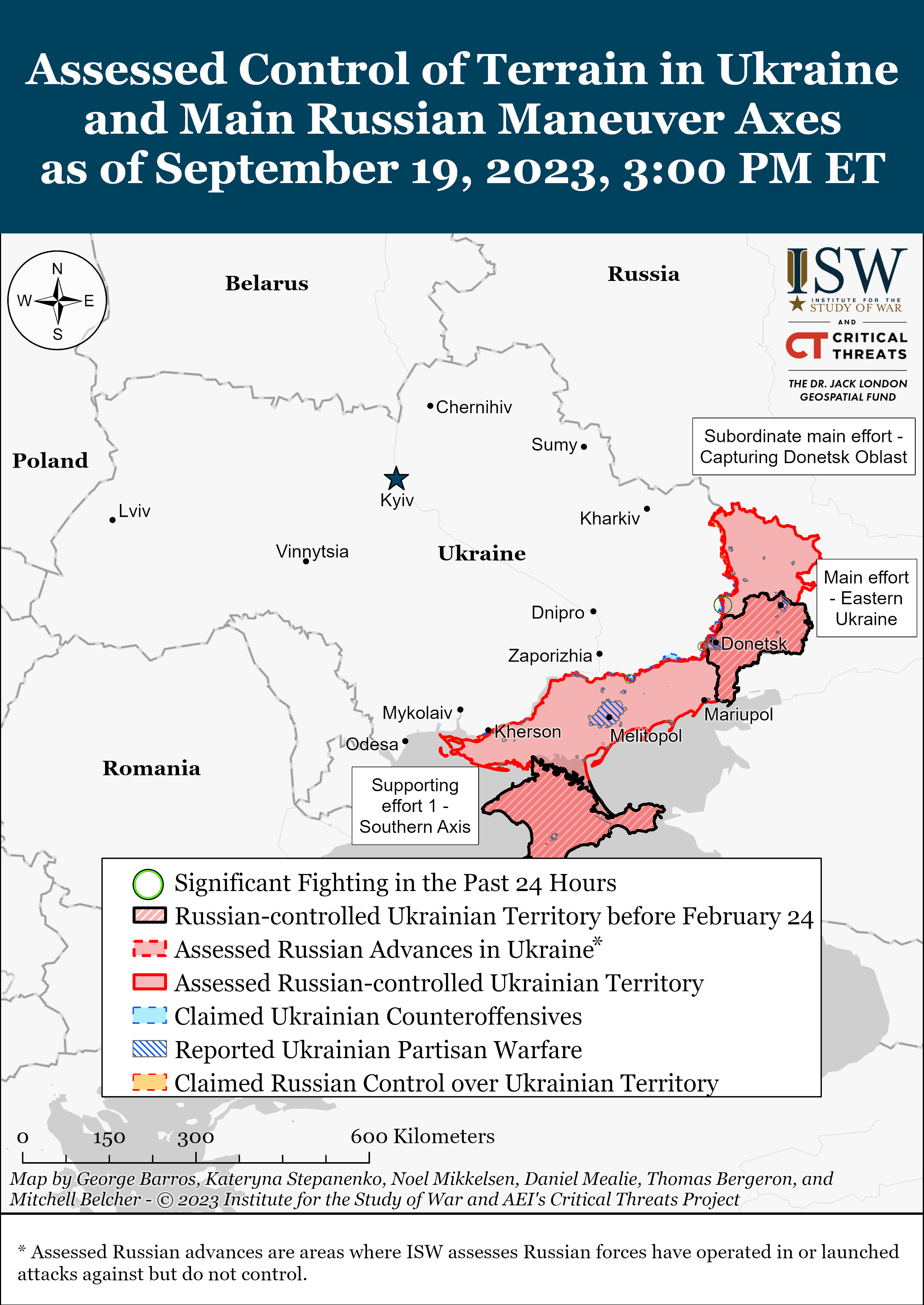
We do not report in detail on Russian war crimes because these activities are well-covered in Western media and do not directly affect the military operations we are assessing and forecasting. We will continue to evaluate and report on the effects of these criminal activities on the Ukrainian military and the Ukrainian population and specifically on combat in Ukrainian urban areas. We utterly condemn these Russian violations of the laws of armed conflict, Geneva Conventions, and humanity even though we do not describe them in these reports.
- Russian Main Effort – Eastern Ukraine (comprised of two subordinate main efforts)
- Russian Subordinate Main Effort #1 – Capture the remainder of Luhansk Oblast and push westward into eastern Kharkiv Oblast and encircle northern Donetsk Oblast
- Russian Subordinate Main Effort #2 – Capture the entirety of Donetsk Oblast
- Russian Supporting Effort – Southern Axis
- Russian Mobilization and Force Generation Efforts
Activities in Russian-occupied areas
Russian Main Effort – Eastern Ukraine
Russian Subordinate Main Effort #1 – Luhansk Oblast (Russian objective: Capture the remainder of Luhansk Oblast and push westward into eastern Kharkiv Oblast and northern Donetsk Oblast)
Russian forces continued offensive operations on the Kupyansk-Svatove-Kreminna line on September 19 but did not make any confirmed gains. Russian milbloggers claimed that Russian forces continued ground attacks west of Kreminna, in the direction of Torske (17km west of Kreminna), in the Serebryanske forest area (11km south of Kreminna), near Bilohorivka (13km south of Kreminna), and near Spirne (25km south of Kreminna).[30] A Russian milblogger claimed that Russian forces maintain pressure against Ukrainian forces northeast of Kupyansk and on the east bank of the Oskil River west of Svatove, but did not reference specific combat engagements.[31] The Ukrainian Ministry of Internal Affairs reported that a Russian airstrike destroyed the bridge across the Oskil River in Kupyansk, likely in an effort to hinder Ukrainian supply efforts across the river.[32] Ukrainian forces maintain control of a number of other bridges across the Oskil, however. Geolocated footage posted on September 17 and 19 shows an element of the Russian 15th Motorized Rifle Brigade (2nd Combined Arms Army, Central Military District) operating near Raihorodka (12km southwest of Svatove) and Nadiya (15km west of Svatove).[33]
Ukrainian forces continued limited offensive operations on the Kupyansk-Svatove-Kreminna line on September 19. Geolocated footage published on September 18 shows Ukrainian forces retreating from southwestern Novoselivske (15km north of Svatove), indicating that Ukrainian forces may retain the ability to reach the outskirts of the settlement.[34] Russian milbloggers claimed that Ukrainian forces periodically attack near Kreminna and Torske (14km west of Kreminna) and in the Serebryanske forest area.[35]
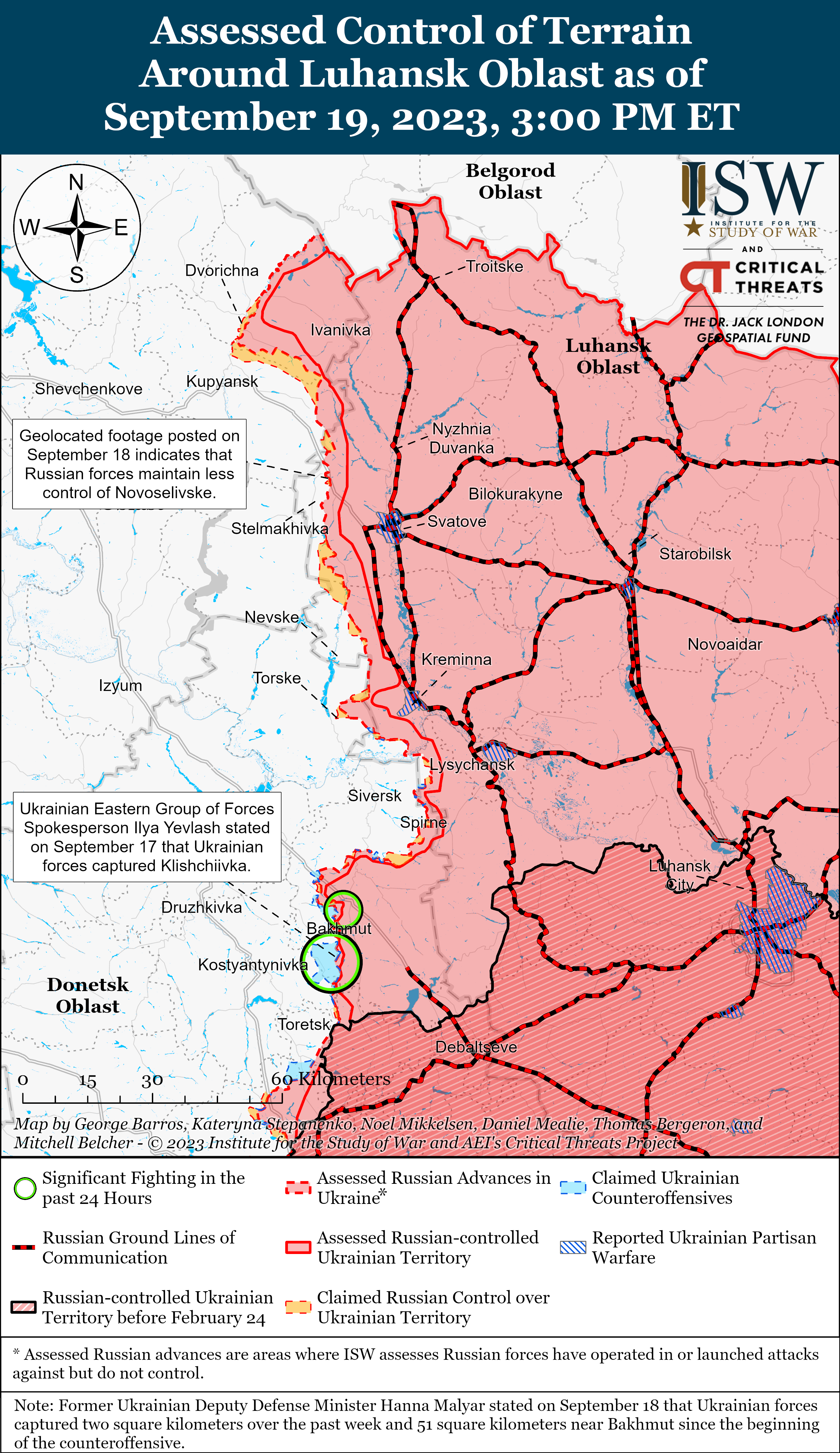
Russian Subordinate Main Effort #2 – Donetsk Oblast (Russian objective: Capture the entirety of Donetsk Oblast, the claimed territory of Russia’s proxies in Donbas)
Ukrainian forces continued offensive operations in the Bakhmut area on September 19 but did not make any confirmed advances. The Ukrainian General Staff reported that Ukrainian forces continue assaults south of Bakhmut and are inflicting significant manpower and equipment losses on Russian forces.[36] Russian milbloggers claimed that fighting continued near Klishchiivka (7km southwest of Bakhmut), Andriivka (10km southwest of Bakhmut), and Kurdyumivka (13km southwest of Bakhmut).[37] Russian milbloggers claimed that most of Andriivka and Klishchiivka are contested “gray zones.”[38] A Russian milblogger claimed that the fiercest battles in the area are occurring near the railway line east of Klishchiivka.[39]
Russian forces counterattacked near Bakhmut on September 19 but did not make any confirmed gains. The Ukrainian General Staff reported that Ukrainian forces repelled Russian assaults west of Yahidne (2km north of Bakhmut) and near Klishchiivka and Andriivka.[40] Russian millboggers claimed that Russian forces counterattacked near Kurdyumivka and in Klishchiivka, where they reportedly established a foothold.[41] ISW has not seen visual confirmation of Russian forces maintaining positions in Klishchiivka, however.
Russian sources claimed that Ukrainian forces conducted limited unsuccessful ground attacks along the Avdiivka-Donetsk City front on September 19. The Russian Ministry of Defense (MoD) claimed that elements of the Russian Southern Grouping of Forces repelled a Ukrainian assault near Kamianka (5km northwest of Avdiivka).[42] A Russian milblogger claimed that recent Ukrainian offensive actions near Opytne (4km south of Avdiivka) and Krasnohorivka (22km southwest of Avdiivka) have not resulted in significant changes to the frontline.[43]
Russian forces continued limited offensive operations along the Avdiivka-Donetsk City front on September 19 but did not make any confirmed gains. The Ukrainian General Staff reported that Ukrainian forces repelled 10 Russian assaults near Marinka (27km southwest of Avdiivka).[44] A Russian milblogger claimed that recent Russian offensive activity near Keramik (10km north of Avdiivka) and the Trudovska mine shaft (near Krasnohorivka) have not significantly changed the frontline.[45]
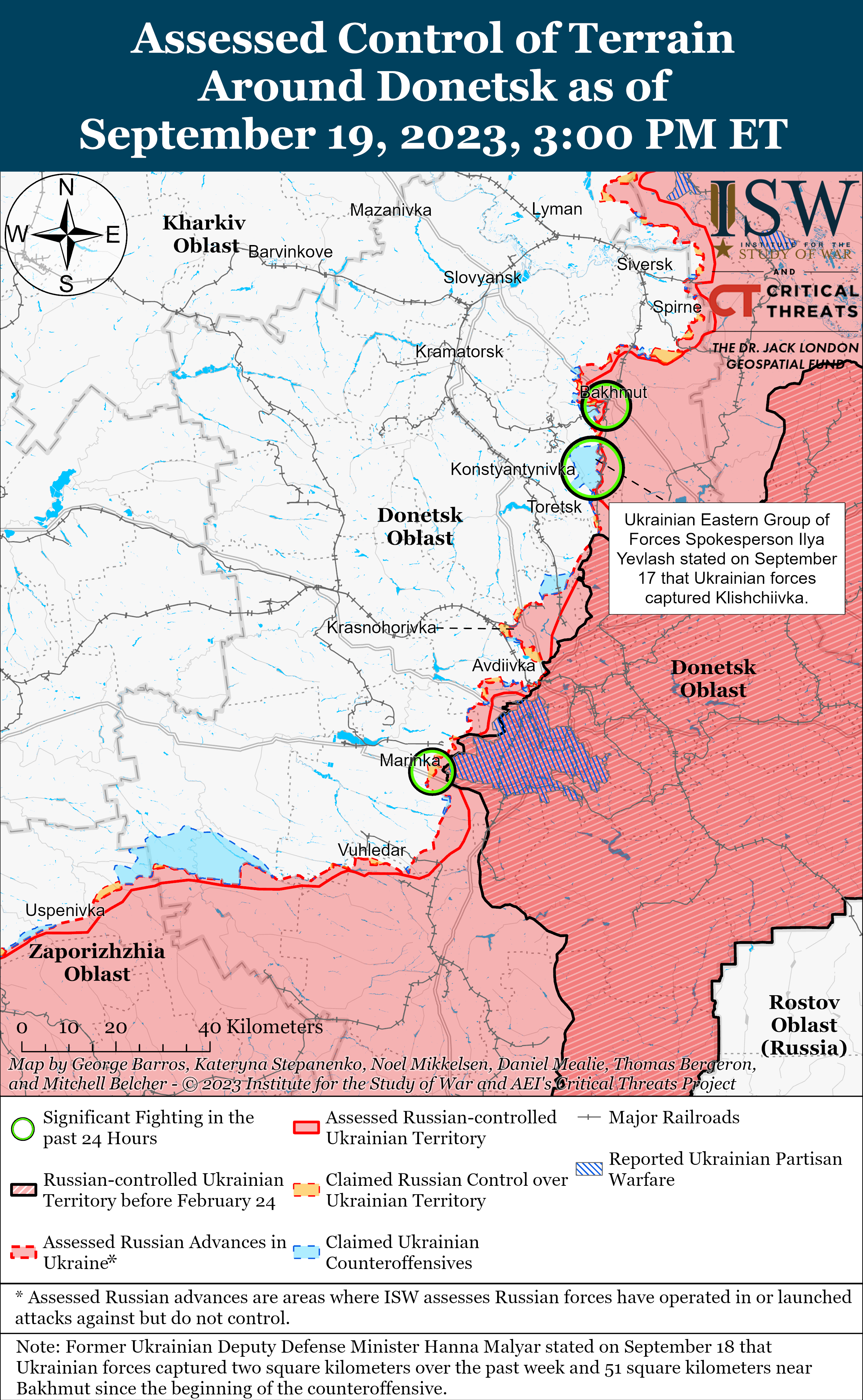
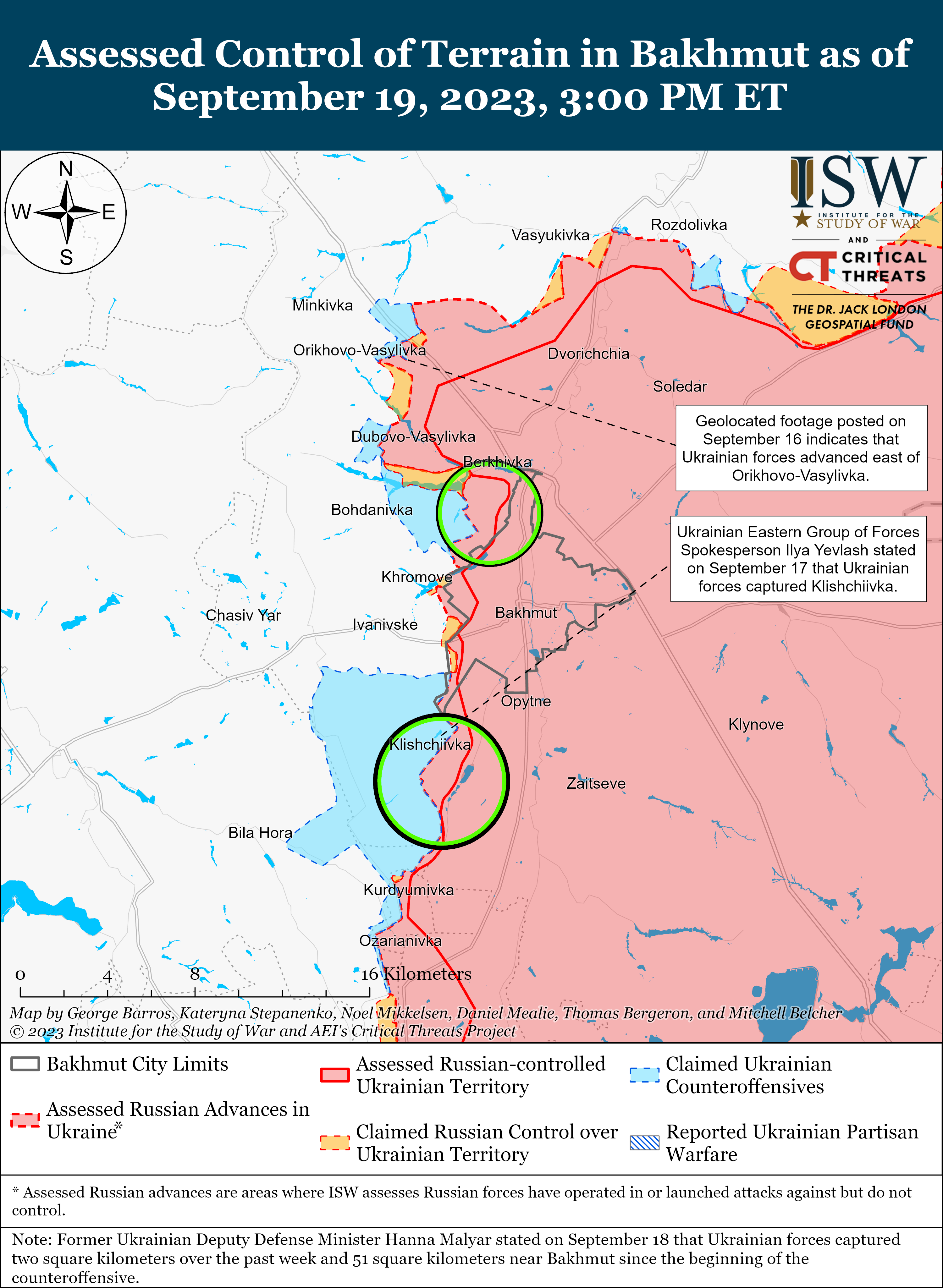
Russian Supporting Effort – Southern Axis (Russian objective: Maintain frontline positions and secure rear areas against Ukrainian strikes)
Ukrainian forces conducted offensive operations in the western Donetsk-eastern Zaporizhia Oblast border area but did not advance on September 19. Russian sources, including the Russian Ministry of Defense (MoD), claimed that Ukrainian forces unsuccessfully attacked near Staromayorske (9km south of Veylka Novosilka), Urozhaine (9km south of Velyka Novosilka), Novodonetske (12km southeast of Velyka Novosilka), and Novomayorske (18km southeast of Velyka Novosilka).[46] Russian milbloggers claimed that Ukrainian forces retreated from the northwestern outskirts of Novomayorske and that fighting has decreased along the Novomayorske-Novodonetske line.[47] A Russian milblogger claimed on September 19 that elements of the Russian 40th Naval Infantry Brigade (Pacific Fleet) repelled Ukrainian attacks near Novomayorske in the western Zaporizhia-eastern Donetsk Oblast border area throughout the past several weeks.[48]
Ukrainian forces conducted offensive operations in western Zaporizhia Oblast on September 19 and advanced. Geolocated footage published on September 18 indicates that Ukrainian forces advanced west of Verbove (18km southeast of Orikhiv).[49] Russian sources, including the Russian MoD, claimed that Ukrainian forces unsuccessfully attacked in the direction of Novoprokopivka (13km south of Orikhiv) and near Verbove, and Robotyne.[50] A Russian milblogger claimed that elements of the Russian 429th Motorized Rifle Regiment (19th Motorized Rifle Division, 58th Combined Arms Army, Southern Military District) repelled a Ukrainian attack near Zherebyanky (26km southwest of Orikhiv).[51] A Russian milblogger claimed on September 19 that Ukrainian forces have advanced along a front seven to nine kilometers wide to a depth of seven kilometers in the area of Robotyne (10km south of Orikhiv) since the start of the counteroffensive.[52]
Russian forces conducted offensive operations in western Zaporizhia Oblast but did not advance on September 19. The Ukrainian General Staff reported that Russian forces unsuccessfully attacked near Robotyne.[53]
A Russian milblogger claimed that several small Ukrainian sabotage and reconnaissance groups landed on the Dnipro River's left (east) bank. The milblogger claimed that Ukrainian forces landed north of Pidstepne (about 12km east of the Antonivsky Bridge) and on Kozatskyi Island (northwest of Nova Kakhovaka) and that Ukrainian forces control the northern part of Kozatskyi Island.[54]
Select Ukrainian and Russian sources stated on September 19 that Ukrainian forces struck two Russian military headquarters in Zaporizhia and Kherson oblasts. The Department of Strategic Communications of the Ukrainian Armed Forces stated that Ukrainian forces struck an unspecified Russian military headquarters near Melitopol in western Zaporizhia Oblast.[55] A Russian insider source claimed that Ukrainian forces struck the Russian 7th Guards Mountain Airborne (VDV) Division headquarters in Kherson Oblast.[56] ISW has not observed visual confirmation of this claim, and other Russian sources have not made similar claims.
The United Kingdom MoD stated that the Russian 40th Army Corps has taken over responsibility for the Kherson Oblast sector of the front.[57] ISW has previously reported on the formation of the new Russian 40th Army Corps as part of the Southern Military District (SMD), and the role of the 40th Army Corps in Kherson Oblast is currently unclear.[58]
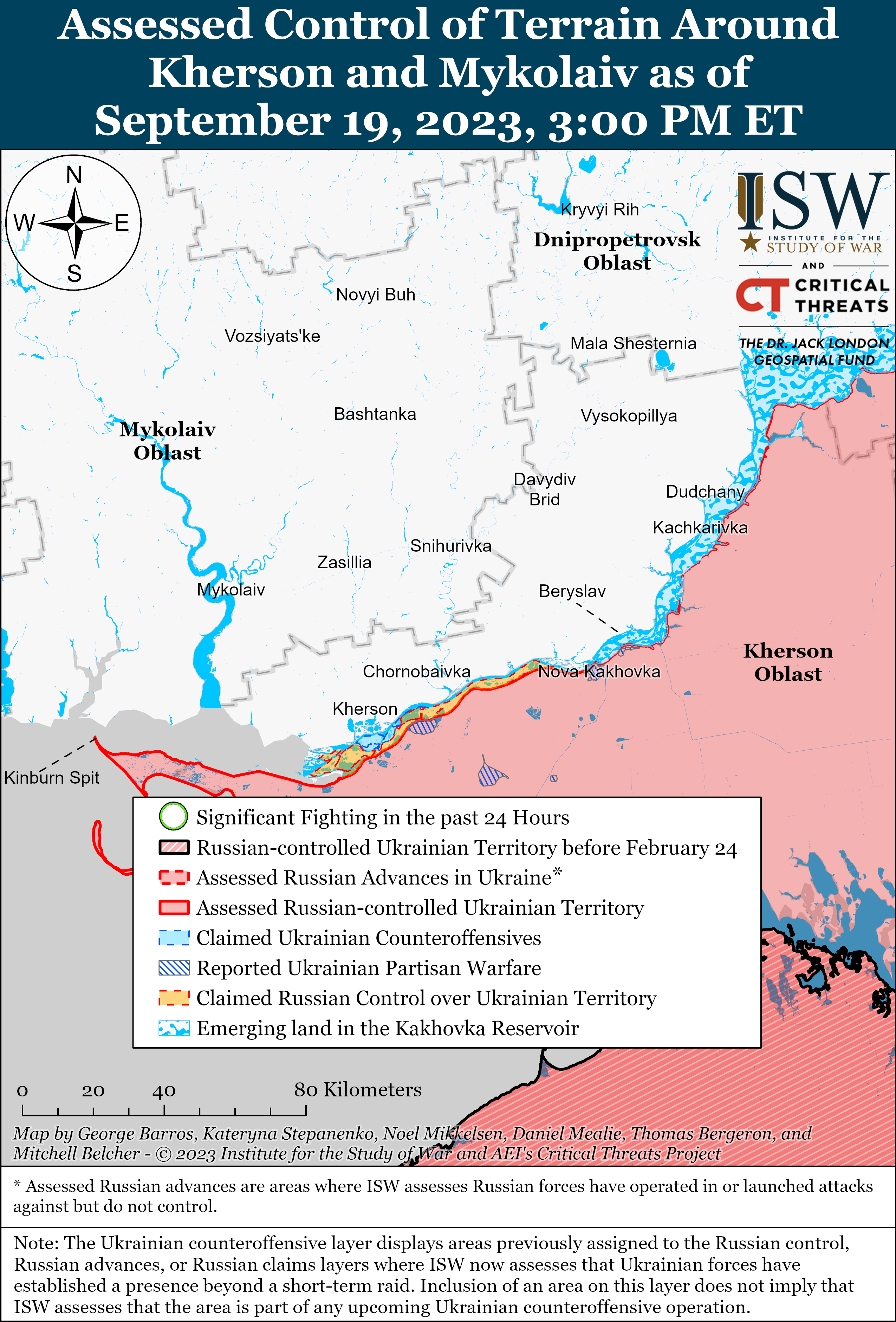
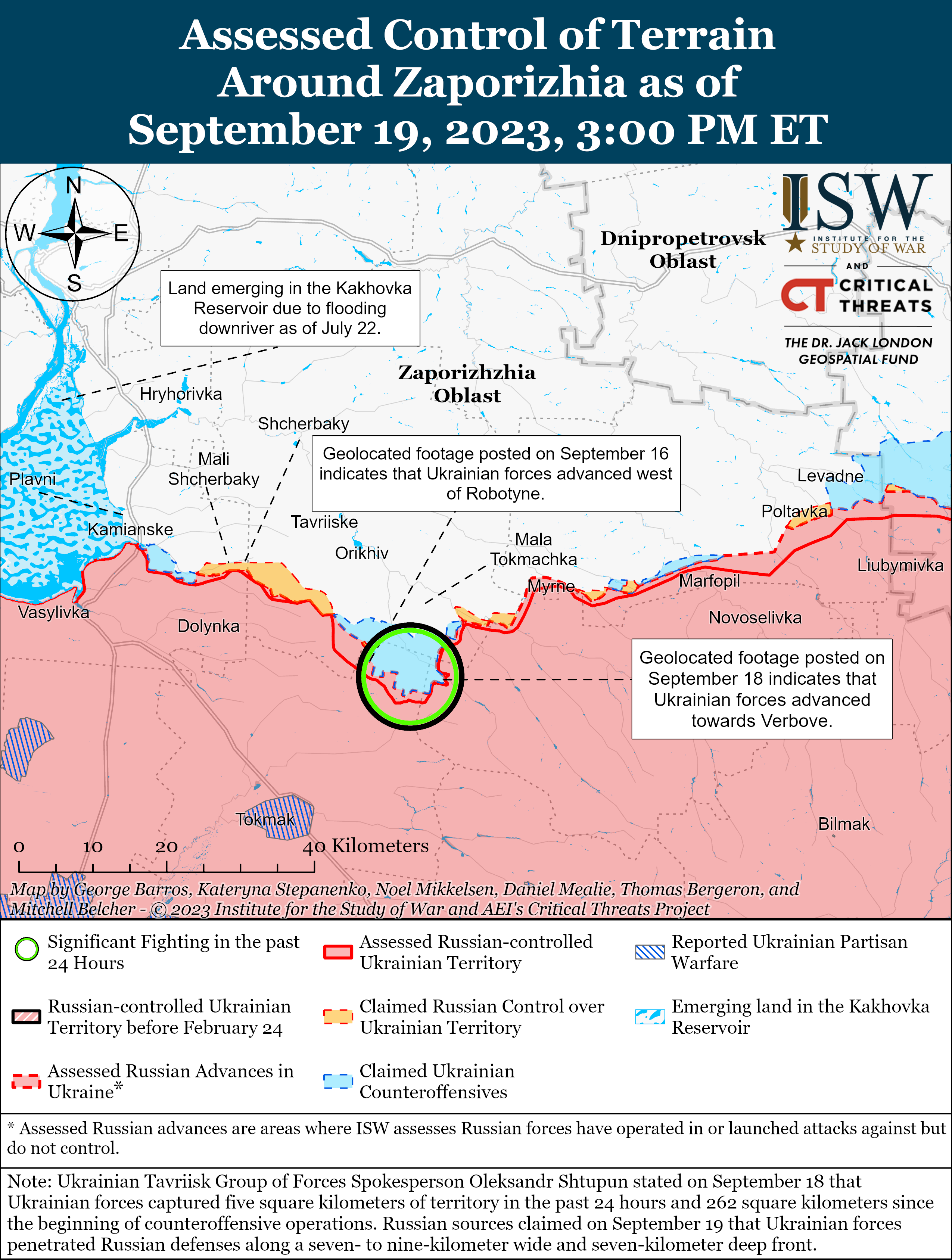
Russian Mobilization and Force Generation Efforts (Russian objective: Expand combat power without conducting general mobilization)
A Latvian company has reportedly been exporting chips and microcircuits to Russian defense industrial base (DIB) companies despite international sanctions designed to prevent Russia from importing such components. Russian opposition outlet the Insider reported on September 19 that the Latvian company Lesta-M has been a key importer of microelectronics to Russia since the start of the Russian full-scale invasion of Ukraine.[59] Lesta-M has reportedly supplied microelectronics to Russian DIB companies, including the Research Institute of Electronic Devices (NIIEP) that develops Russian Iskander missiles and the US-sanctioned “Kupol” Izhevsk Electromechanical Plant that develops Tor-M2E anti-aircraft missile systems.[60] However, the Insider reported that Lesta-M microelectronics have not yet appeared in downed Russian missiles.[61]
A Russian official stated that Russia will launch a digital registry in 2025 of those eligible for military service. Deputy Minister of Digital Development Oleg Kachanov stated on September 19 that Russia will launch the digital register in 2025, which will notify conscripts via electronic summonses.[62] Kachanov noted that Russian authorities will test the digital register in one or two unspecified Russian federal subjects by the end of 2023, however.[63] Russian President Vladimir Putin approved a law on April 14 to create a digital register that will allow Russian military registration and enlistment offices to send electronic summonses to citizens eligible for conscription.[64]
A Russian milblogger indicated that the Russian military command continues to view Russian penal recruits as expendable manpower to attack with on certain areas of the frontline. The milblogger claimed that only 7 of 48 “Storm-Z” unit personnel survived an attack on an unspecified settlement on September 18 and that Chechen forces participating in the assault also sustained similar casualty rates.[65] The milblogger complained that the Russian command “abandoned” the attacking units in broad daylight without reconnaissance or artillery support, leaving the Russian infantry vulnerable to Ukrainian air, artillery, and tank fire. The milblogger complained that Russian artillery only began covering a small infantry group when the group captured a small foothold on the outskirts of the unspecified settlement. Russian “Storm-Z” units are hastily formed units primarily comprised of penal colony recruits, which the Russian military command has increasingly used to conduct assault operations on the Kupyansk-Svatove-Kreminna line despite high casualty rates.[66]
Activities in Russian-occupied areas (Russian objective: Consolidate administrative control of annexed areas; forcibly integrate Ukrainian citizens into Russian sociocultural, economic, military, and governance systems)
The Russian military reportedly continues to forcibly mobilize Ukrainian civilians in occupied areas. Ukrainian Luhansk Oblast Head Artem Lysohor reported on September 19 that the Russian military is forcibly mobilizing people in unspecified occupied areas and noted that military registration and enlistment officers have been updating data on residents of occupied Polovynkyne, Starobilskyi Raion, Luhansk Oblast.[67] The Kherson Oblast occupation Ministry of Internal Affairs (MVD) reported on September 18 that it is adding all civilians in occupied Kherson Oblast with Russian passports to the Russian military register.[68] The Kherson Oblast occupation MVD claimed that Russian occupation officials are adding civilians with Russian passports to the military register in accordance with Russian law and do not intend to conscript or mobilize civilians, however.[69]
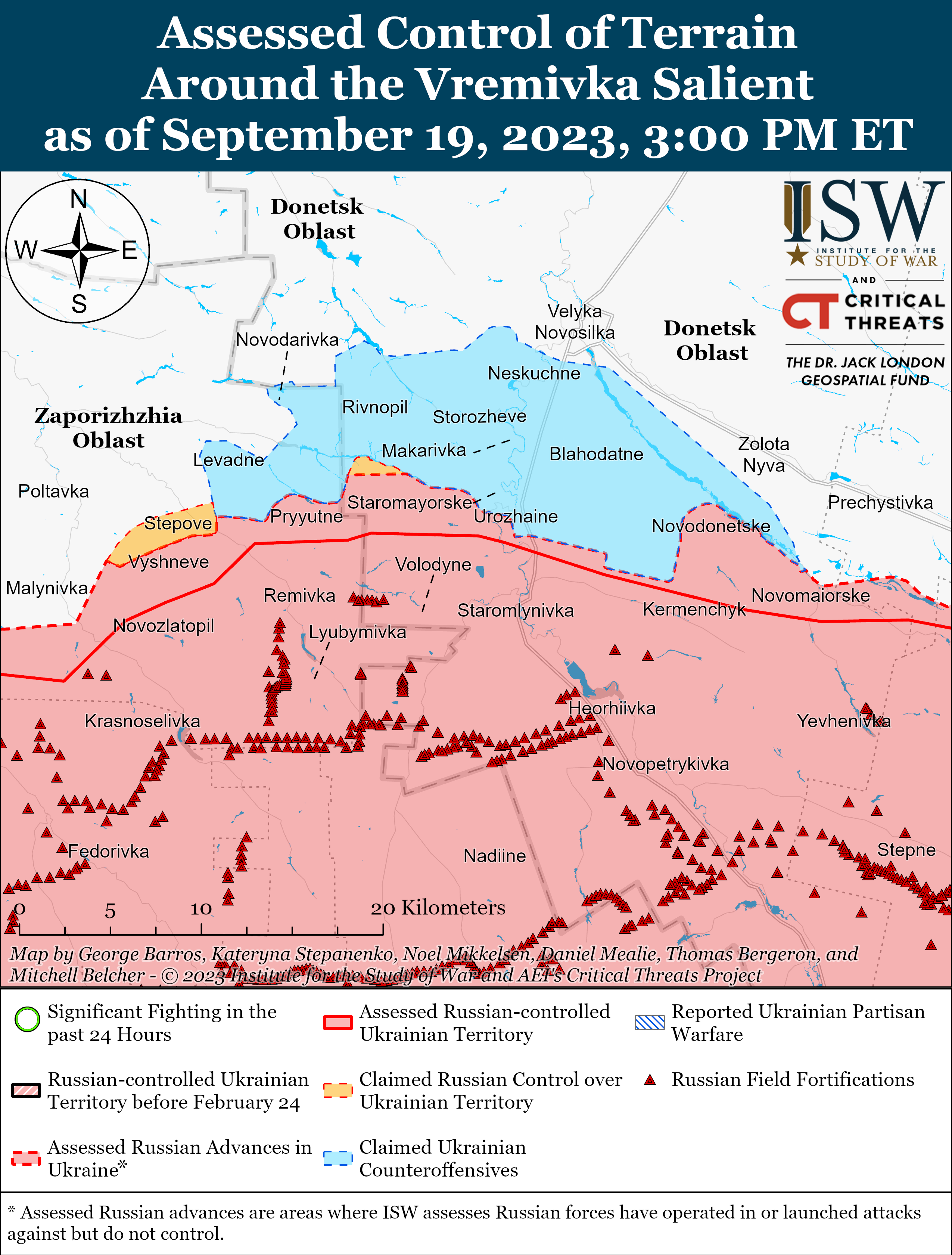

Significant activity in Belarus (Russian efforts to increase its military presence in Belarus and further integrate Belarus into Russian-favorable frameworks and Wagner Group activity in Belarus)
Radio Free Europe/Radio Liberty published satellite imagery on September 18 showing a decrease in the number of tents at the Wagner Group camp in Tsel, Belarus and reported that all the tents were dismantled.[70] The Ukrainian National Resistance Center reported on September 17 that fewer than 1,000 Wagner personnel remain in Belarus and that 200 other Wagner personnel remain to train Belarusian Ministry of Defense (MoD) and Ministry of Internal Affairs (MVD) forces.[71]
Belarus continues efforts likely aimed at supporting the Kremlin’s sanctions evasion schemes. Belarusian President Alexander Lukashenko met with Krasnodar Krai Head Veniamin Kondratyev on September 19 to negotiate on industrial trade and boasted about Russia’s willingness to invest in Belarusian microelectronics production capabilities.[72] The Belarusian MoD reported that it received a Vietnamese MoD delegation to discuss bilateral logistical support cooperation, which Belarus would likely use to support Russian logistics.[73]
No comments:
Post a Comment